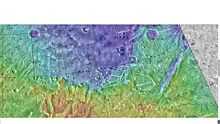Perepelkin (Martian crater)

Perepelkin Crater is an impact crater in the Arcadia quadrangle of the planet Mars. It is located at 52.8°N latitude and 64.6°W longitude. It is 112.0 km in diameter. It was named after Yevgeny Perepyolkin; the name was approved in 1973 by the by the International Astronomical Union (IAU) Working Group for Planetary System Nomenclature (WGPSN).[1] Much of the crater is covered with a mantle that is believed to be ice-rich and to have fallen from the atmosphere when the climate was different. In one of the images below mantle can be seen; also some places when the mantle has disappeared, channels are visible.
Mantle
Researchers have noticed a smooth mantle covering much of Mars.[2] Some parts are eroded, revealing rough surfaces. Some parts possess layers. It’s generally accepted that mantle is ice-rich dust that fell from the sky as snow and ice-coated dust grains during a different climate [3] One evidence of its ice-rich nature is the presence of gullies which form when some of the ice melts.[4][5][6] Only a few hours of flow can result in erosion .[7] In higher latitudes, such as around Milankovic Crater, the mantle is thicker and may contain rounded shapes called scallops .[8] These are thought to be caused by the sublimation of ice in the mantle. Several models have been advanced to explain them; some include a small amount of melting at times.[9][10][11][12]
-

Perepelkin Crater, as seen by CTX camera (on Mars Reconnaissance Orbiter).
-

Channels and mantle, as seen by CTX camera (on Mars Reconnaissance Orbiter). Channels are exposed where the mantle has disappeared.
See also
References
- ↑ "Gazetteer of Planetary Nomenclature | Perepelkin". usgs.gov. International Astronomical Union. Retrieved 4 March 2015.
- ↑ Mustard, J., C. Cooper, M. Rifkin. 2001. Evidence for recent climate change on Mars from the identification of youthful near-surface ground ice. Nature 412, 411–414 .
- ↑ Pollack, J., D. Colburn, F. Flaser, R. Kahn, C. Carson, and D. Pidek. 1979. Properties and effects of dust suspended in the martian atmosphere. J. Geophys. Res. 84, 2929-2945.
- ↑ Raack, J., D. Reiss, and H. Hiesinger. 2012. Gullies and their relationships to the dust-ice mantle in the northwestern Argyre Basin, Mars. Icarus 219, 129-141.
- ↑ Schon, S. and J. Head. 2011. OBSERVATIONS OF GULLY DEVELOPMENT IN GASA – A RAYED CRATER. 42nd Lunar and Planetary Science Conference 2546.pdf
- ↑ Schon, S. and J. Head. 2012. Gasa impact crater, Mars: Very young gullies formed from impact into latitude-dependent mantle and debris-covered glacier deposits? Icarus 218, 459–477.
- ↑ Dickson, J., and J. Head. 2009. The formation and evolution of youthful gullies on Mars: Gullies as the late-stage phase of Mars’ most recent ice age. Icarus 204, 63–86.
- ↑ Lefort, A., P. Russell, N. Thomas, A. McEwen, C. Dundas, R. Kirk. 2009. Scalloped terrains in the Peneus and Amphitrites Patera region of Mars as observed by HiRISE. Icarus 205, 259-268.
- ↑ Soare, R., J. Kargel, G. Osinksi, F. Costard. 2007. Thermokarst processes and the origin of crater-rim gullies in Utopia and western Elysium Planitia. Icarus 191, 95-112.
- ↑ Lefort, A., P. Russell, N. Thomas, A. McEwen, C. Dundas, R. Kirk. 2009. Scalloped terrains in the Peneus and Amphitrites Patera region of Mars as observed by HiRISE. Icarus 205, 259-268
- ↑ Ulrich, R., T. Kral, C. Chevrier, R. Pilgrim, L. Roe. 2010. Dynamic temperature fields under Mars landing sites and implications for supporting microbial life. Astrobiology 10, 643-650.
- ↑ Soare, R. and G. Osinski. 2009. Stratigraphical evidence of late Amazonian perglaciation and glaciation in the Astapus Colles region of Mars. Icarus 202, 17-21